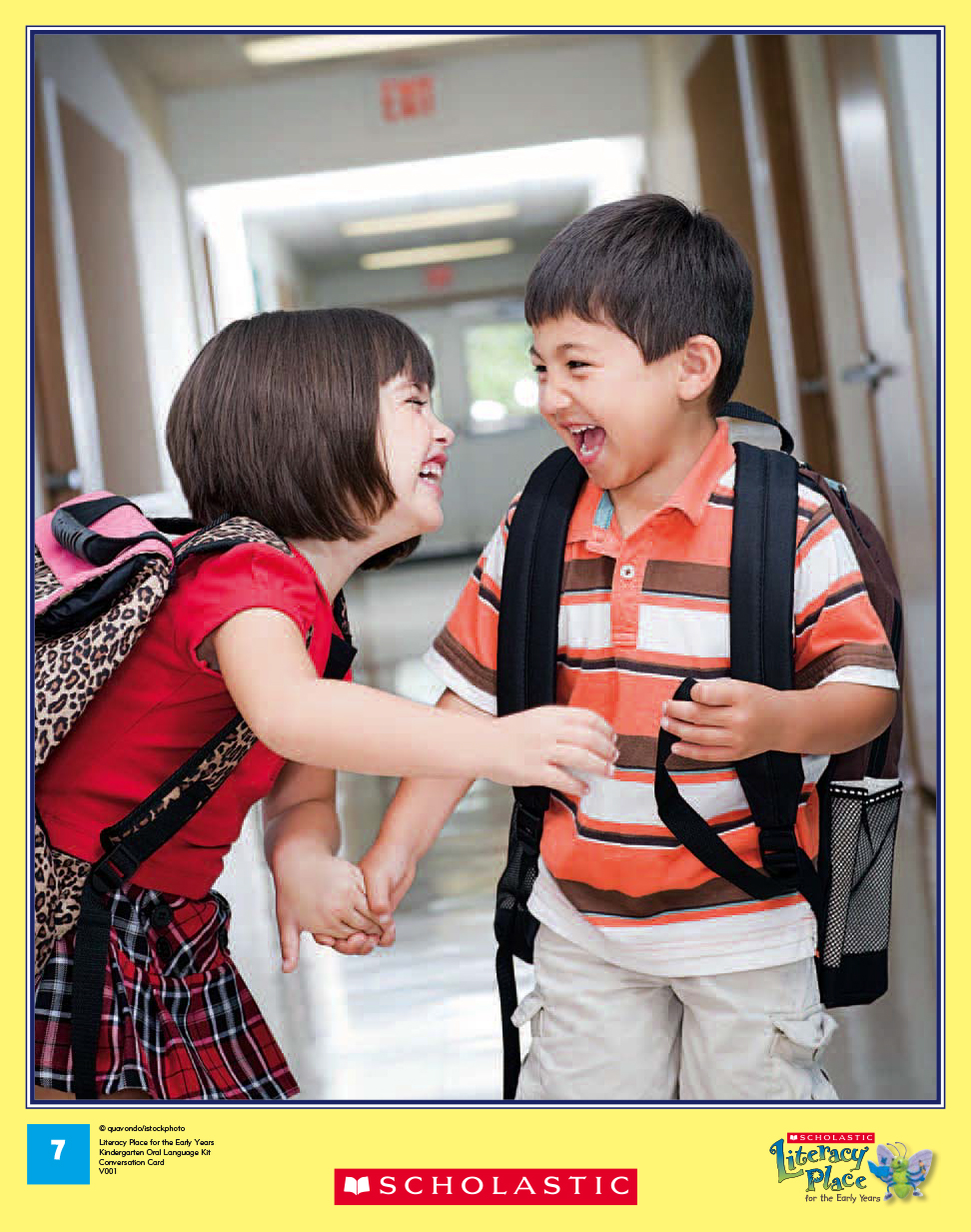Oral Language Teaching Strategy:
Encourage Partner Talk Enourage students to talk through their ideas with a partner before sharing their ideas with the group.
Time: one 30-minute lesson or two 15-minute lessons
Materials: Emotions/Interactions Card #7
Grouping: whole class or small group
Assessment: Kindergarten Oral Language Assessment Scale
FOCUSING ON THE PICTURE
[Analyzing/inferring]-
What is happening in the picture? Where do you think these children are? Why?
Show students the picture. Provide prompts to deepen their observations.
-
Sharing ideas with a partner helps us make sense of our ideas.
After students have had time to analyze the picture, ask them to share their ideas with a partner. -
After students have had sufficient time for partner discussion, invite a few pairs to share their ideas with the group.
- Offer prompts to stimulate discussion:
- Where are these children? Why do you think that?
- Are the children alone? Who might be with them?
- What time of day do you think it is? What clues does the picture give you?
GOING DEEPER
[Inferring/evaluating]- Offer open-ended prompts that focus the students on the emotions and the interaction portrayed:
- How do you think the boy is feeling? What clues tell you this? What is his mouth doing? His eyes? His hands?
- How do you think the girl is feeling? What clues tell you this?
- Why do you think they have backpacks? What does that tell you?
- What else can you see in the picture? What does that tell us about where they are?
- What do you think they are saying to each other?
Teaching Tip: This photo provides an excellent starting point to discuss how body language can tell us how someone else is feeling. This is often a difficult thing for students to pick up. Ask students how the girl might act differently if the boy was feeling and acting angrily.
You may conclude the lesson at this point and do the second part on the next day, or you may decide to continue and do Connecting and Predicting as part of the first lesson.
CONNECTING
Teaching Tip: If you decide to do Connecting and Predicting on the second day, begin your lesson by reviewing the picture with the students.
[Making connections]
- Have students draw on their personal experiences to make connections to the children in this picture. Have them share what they laugh about with their friends. Prompts to deepen discussion might include:
- Have you ever felt like the children in this picture? How did you feel?
- What makes you laugh? What makes you happy?
- What are your favourite things to do with your friends?
Have you ever laughed this hard with your friend? What do your friends do to make you laugh? How did it make you feel? How do you try to make your friends laugh?
Offer specific prompts that fit the discussion you have had with the group. Have students close their eyes and listen to you as you ask these questions.
-
Have students turn to a partner and share what they thought about. After they have had time for both partners to share, have a few students share their ideas with the group.
PREDICTING
[Predicting]-
What do you think happened just before this scene? Why do you think this?
Ask students to think about what might have happened just before the scene in this photo.
-
Brainstorm with students possible scenarios that may have occurred before the scene in this photo. The group could choose one possible scenario and act it out with partners.
LESSON EXTENSIONS
- Together with students create a mind map listing characteristics of a good friend. After you have created the mind map, read some books about friendship with a focus question like, “What makes a good friend?” Add to your mind map as you read. Some great friendship books are:
- Rosie and Michael by Judith Viorst
- The Best Friends Book by Todd Parr
- Just My Friend and Me by Mercer Mayer
- At the art centre have students complete the sentence starter ‘Good friends are… ’ Then have them draw or paint a picture to illustrate their sentence. Compile their drawings to create a class book.
- Read a funny story or poem to students. As students laugh, discuss how they feel when they laugh. What does it look like, sound like, feel like?
- Together, brainstorm what the girl and boy might have said to each other. Using sticky notes create speech bubbles to add above their heads. Discuss the convention of speech bubbles.
FOLLOW-UP IN CENTRES
-
Write descriptive words on cards such as ‘kind,’ ‘funny,’ ‘happy’ and have students act out the scenario in the picture the sway it is described on the card.
-
Provide a collection of friendship books for students at the reading centre.
-
Provide a blank book entitled ‘Friends Are…’ that students can write or draw in about friendship.

